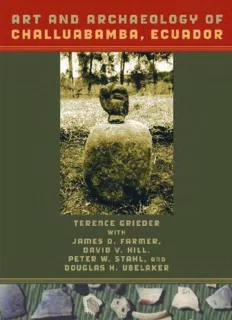
Art and Archaeology of Challuabamba, Ecuador PDF
Preview Art and Archaeology of Challuabamba, Ecuador
Art and Archaeology of Challuabamba, Ecuador Art and Archaeology of Challuabamba, Ecuador By Terence Grieder Professor Emeritus, History of Art, The University of Texas at Austin with James D. Farmer Chair, Dept. of Art History, Virginia Commonwealth University, Richmond David V. Hill Archaeological consultant, Denver, Colorado Peter W. Stahl Professor of Anthropology, SUNY, Binghamton Douglas H. Ubelaker Curator of Physical Anthropology, Smithsonian Institution, Washington, D.C. university of texas press austin All photographs, drawings, and diagrams are the work of Terence Grieder unless otherwise credited. Copyright © 2009 by the University of Texas Press All rights reserved Printed in the United States of America First edition, 2009 Requests for permission to reproduce material from this work should be sent to: Permissions University of Texas Press P.O. Box 7819 Austin, TX 78713-7819 www.utexas.edu/utpress/about/bpermission.html ∞ The paper used in this book meets the minimum requirements of ANSI/NISO Z39.48-1992 (R1997) (Permanence of Paper). Library of Congress Cataloging-in-Publication Data Grieder, Terence. Art and archaeology of Challuabamba, Ecuador / by Terence Grieder ; with James D. Farmer . . . [et al.]. — 1st ed. p. cm. Includes bibliographical references and index. ISBN 978-0-292-71892-0 (cloth : alk. paper) 1. Challuabamba Site (Ecuador). 2. Cañari Indians—Ecuador— Cuenca—Antiquities. 3. Indian pottery—Ecuador—Cuenca. 4. Effigy pottery—Ecuador—Cuenca. 5. Pottery figures— Ecuador—Cuenca. 6. Indian seals (Numismatics)—Ecuador— Cuenca. 7. Excavations (Archaeology)—Ecuador—Cuenca. 8. Cuenca (Ecuador)—Antiquities. I. Title. F3722.1.C2G75 2008 986.6'24—dc22 2008039552 contents Author’s Note vii Acknowledgments ix 1 Introduction to the Project 1 2 Pottery Wares and Forms 27 3 Petrographic Analysis of Selected Ceramics from Two Sites in Ecuador 53 david v. hill 4 Pottery Decoration 61 5 Pottery Comparisons 84 6 Effigy Vessels and Figurines 97 7 Stamps and Seals 111 8 Stone and Shell 128 9 The Burials and Their Offerings 141 james d. farmer 10 Human Remains 159 douglas h. ubelaker 11 Zooarchaeology 165 peter w. stahl 12 Reconstructing Challuabamba’s History 207 Index 219 THIS PAGE INTENTIONALLY LEFT BLANK author’s note This book reports the results of excavations at Challuabamba, in Ecuador, during the years 1995–2000. It brings together studies by a group of specialists working independently and cooperatively to present a view of this ancient site. When someone looking at the pic- tures asked why all the pottery was broken, I realized that an expla- nation was needed. Most of the pots were broken in use or crushed in burials long ago. Restoration of ancient pottery is a time-consuming project for specialists. Our project promised to leave every artifact with the Ecuadorian National Institute of Cultural Patrimony, tak- ing with us only our notes, drawings, and photographs. Our photo- graphs show pots which have been washed and given a minimum restoration with water-soluble glue, to give observers the basic idea. For museum display they will need to be disassembled and rebuilt by experts with adequate time and techniques for that work. vii THIS PAGE INTENTIONALLY LEFT BLANK acknowledgments The principal funding for the Challuabamba project came from re- search funds of the David Bruton Jr. Professorship in the History of Art at the University of Texas at Austin, augmented by substan- tial gifts from Dana DeBeauvoir and an anonymous donor. The zoo- archaeological study by Peter Stahl was supported by the National Science Foundation (BCS-0130588). The Instituto Nacional de Patri- monio Cultural del Ecuador authorized these studies each year from 1995 to 2000. Dra. Mónica Bolaños expedited that process, under the supervision of Ldo. Carlos Guerrero B., the national director. The regional director in Cuenca, Srta. Mónica Zabala D., supervised our work and archaeologist Byron Camino participated in the work as in- spector for the institute. Archaeologist Antonio Carrillo represented the institute and made a valuable contribution to the work. The 1995 excavation was made on the property of Francisco Chim- bo, who permitted the work and took an interest in it. In the follow- ing years (1996–2000), the excavations were made on the neighbor- ing property of the Jaramillo family through the kind permission of Juan Pablo Jaramillo. In 1995 the Texas group consisted of Senja Foster and Elizabeth Jenkins, graduate students at the University of Texas, Dagmar Grie- der, and the project director (Terence Grieder), with a faithful local crew of Teresa Balarezo and members of her family, who continued in the following years. In 1996 the participating Texas students were Bradford Jones, Yvonne Rocha, and Mark Brignole. Manuel Guayas also joined the crew. In 1997 James Farmer joined us, bringing stu- dents Maria Naula and Julie White from Virginia Commonwealth University; and in 1998 Bradford Jones, Terence Grieder, and An- tonio Carrillo supervised the work. Laboratory analysis occupied a larger share of the time each year. In 1999 the GPR-magnetometer survey was conducted by Mark Willis and Joe Brandon. Cuts 4 and 5 were based on that survey. ix
Description: